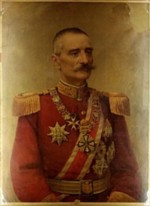Skopje
We began in Skopje North Macedonia where we were to pick up a car for this leg off our travels.
Skopje is the capital, the largest city and the principal centre of culture and commerce in this small landlocked country to the north of Greece.
Downtown Skopje - Soviet Modern
Skopje's appearance today stems from an earthquake that, in 1963, destroyed 80 percent of the city; killing over 1,070 people; injuring between 3,000 and 4,000; and leaving more than 200,000 people homeless. At that time North Macedonia was part of the Socialist Federal Republic of Yugoslavia a non-aligned state. So, both the United States and the Soviet Union rushed to lend a hand. Like Tashkent, that would be destroyed similarly three years later (Read more...), the city was rebuilt, along Soviet modern lines.
The country's name has long been a source of contention with Greece due to its association with King Philip II of Macedon (359 BCE - 336 BCE) - the father of Alexander the Great (356 BCE - 323 BCE). Alexander was the conqueror of much of the known world and founder of the enormous Hellenic (Greek) Empire that extended all the way to Tajikistan. Read more...
Alexander was born in his father's capital of Pella, the ruins of which are in Greece, a whole 25 kilometres south of the North Macedonia border. Thus, his kingdom obviously encompassed both countries. But let's fight about it.
But this land is no longer a prize to be fought over. The economy has not recovered after the collapse of Yugoslavia and the unemployment rate is exceeded only by Bosnia and Herzegovina and Kosovo. This is not helped by its big neighbour Greece that's next on the list.
A few things survived the 1963 earthquake, among these are: the Stone Bridge across the Vardar River, also known as the Dušan Bridge after Stephen Dušan, Emperor of Serbia, who united much of the Balkans in the 14th century; and the Old Bazaar area, a market place and surrounds, known for its Muslim cultural and historical values, now, bizarrely, home to a number of pubs and drinking holes beloved by tourists.
Stone Bridge (Dušan Bridge) across the Vardar River; Skopje Fortress; and a bar - but not in the Bazaar
Another tourist attraction is Skopje Fortress, built on a hill fortified since the Neolithic period. In 6th century CE the Romans built a fort here that survived several earthquakes and continued to impress visitors throughout the Byzantine period, until the mid-15th century, but then fell into disrepair under the Ottomans. The present faux walls were very recently rebuilt to surround the ancient ruins, now mainly rubble. While still under construction in 2011 these apparently innocuous walls were a source of local sectarian protest. I'm sure there was a good reason.
The Archaeological Museum of Macedonia traces the region's very long history of civilisation and technological advance, from the Neolithic through the bronze and iron ages to the common era. The multitude of prevailing religions is reflected in the many artefacts on display from: Roman and Greek polytheism together with Zoroastrian monotheism; to later Jewish, Christian and Muslim beliefs.
The Archaeological Museum of Macedonia and Mother Teresa - now Saint Teresa of Calcutta
For many, their greatest awareness of Skopje is that it was the birthplace of Mary Teresa Bojaxhiu (born: Anjezë Gonxhe Bojaxhiu) an Albanian Christian who became the nun known as Mother Teresa of Calcutta. After a very long beatification (Read more...) she is now a Saint: Saint Teresa of Calcutta, thanks to Pope Francis.
At the time of her birth Northern Macedonia was part of the Kosovo Vilayet of the Ottoman Empire. Roman Christianity was a minority religion among Eastern Orthodox Christians and Muslims. Elsewhere in the Ottoman Empire, particularly in Turkey, Christians were being hunted down and killed and/or forcibly expelled. So, the Bojaxhiu family were politically active.
At the age of 18 Anjezë was 'called' and left for Ireland to join the Sisters of Loreto, at Loreto Abbey near Dublin. After initial training she began her novitiate in Darjeeling India where she taught in a school. By 1937 she was a teacher in Calcutta advancing to headmistress in 1944. Then came the Partition of British India.
In 1946 Calcutta descended into ruin, from which it has not recovered (read more at the above link) and Mother Teresa abandoned the school to set up her mission. The rest is history.
Possibly Matka Canyon - nice anyway
Our hotelier told us that on the way out of Skopje we should take a look at Matka Canyon. TomTom didn't seem to know where to go and so led us on an 'interesting' drive through rural landscapes and forest lanes, giving me an opportunity to get used to the new car's idiosyncrasies. Eventually we reached this pleasant spot. But is it the famed canyon?

